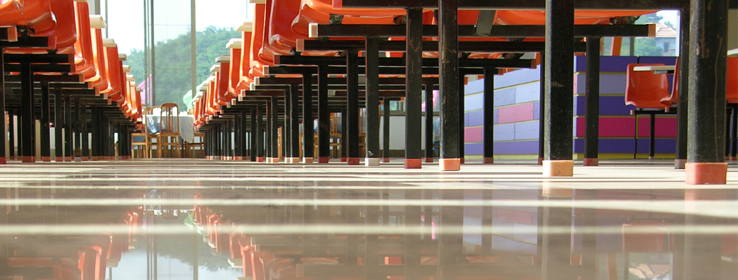Where, when and why to install one or the other.
The choice of polished or stained concrete floors goes beyond a desire for a mirror finish or rustic patina. It also depends largely on the customer's budget, planned usage and maintenance expectations. For expert insight, we talked with Jeff Eiswerth, Sherwin-Williams concrete coatings specialist with H&C Decorative Concrete Products in Cleveland, Ohio, and Jim Hammond, owner of Centaur Contracting, a decorative painting company in Peninsula, Ohio.
Help customers make the right flooring decisions for long-term satisfaction
Being a successful decorative concrete professional requires more than technical expertise. Jeff Eiswerth from Sherwin-Williams says contractors also need to go the extra mile by:
• Starting with thorough on-site inspections. This means carefully assessing the existing substrate condition, looking for cracking, spalling or other issues that may adversely affect project objectives.
• Asking good questions. This often begins with determining what aesthetic look or feel the customer wants from the flooring project. In addition, it's imperative to ask how the surface will be used. For example, will the floor need to handle just small groups — or thousands of people and the pounding of heavy equipment? Finally, clarify the budget requirements. "If a client only has $2 per square foot to spend, you're sure not going to be talking with them about polished concrete," Eiswerth says.
• Managing customer expectations. As work gets underway, it's always smart to provide mockup samples of the finished color and texture for customer approval. That way, the customer has a visual representation of each upcoming step, ensuring that there are no surprises. Talk to the experts at your Sherwin-Williams store — they can consult with you to develop the mockups you need for each specific project.
What are the key differences between stained and polished concrete floors?
Jim: "Typically, polished concrete jobs are about $5 to $8 higher per square foot than a stained contract project. That upfront cost is higher because it requires more equipment and has a more involved installation process. However, when larger companies do the math, they often find that the return on investment for polished concrete durability is quite good. On the other hand, a stained concrete floor is essentially a coating system designed to achieve a desired look. For that reason, customers need to be more diligent about protecting and maintaining those coatings."
What are the best applications for each type of flooring?
Jim: "For polished concrete, you're talking about high-wear areas, such as large retail stores, warehouses, stadium concourses or even restaurants that choose to invest the upfront expense in exchange for lower maintenance. With stained concrete, examples might be salons, smaller retail shops, restaurants or residential patios — anywhere people really want that variegated look from an acid-etch stain, or the faux finish you can get from acetone dye or semi-transparent stain products."
Can you provide a quick installation overview for polished and stained concrete?
Jeff: "For polished concrete, you typically prepare the surface with a planetary grinder to open up the concrete pores. Then, you follow up with multiple passes of successively finer-grit diamond products, along with chemicals like H&C® Clear Liquid Hardener & Densifier, to get the finish you want. If the customer wants color, the contractor could use H&C® Acetone Dye Stain [apply color before densifying] and then finish it off with a guard coat such as H&C® Lithium Protective Finish.
"On stained concrete projects, there are some differences. With an acid stain, like H&C® Infusion™ Reactive Acid Stain, the color is literally etched or ‘burned' into the concrete, so etching is not needed in the surface preparation steps. With other stain product options — such as H&C® Semi-Transparent Decorative Concrete Stain or H&C Acetone Dye Stain — the contractor needs to use either mechanical grinding or an acid wash for surface preparation. Generally we recommend the acid wash, because if grinding isn't done properly, it can leave visible imperfections in the finished product. To protect a semi-transparent stain, acetone dye stain or infusion acid stain, be sure to use a product like our H&C® High Performance Industrial Clear Coat."
Are there substantial maintenance differences between these surfaces?
Jeff: "While there's no such thing as a ‘no maintenance' surface, polished concrete is probably the lowest overall maintenance system that H&C sells. When you polish concrete it closes the pores. That helps it resist staining and moisture, so routine maintenance is basically a powered floor scrubber, a wet mop or a neutral cleaner. While daily maintenance on a stained concrete floor is essentially the same, there is more long-term expense in reapplying clear coats or protective waxes. The life of the coating system is largely dependent on wear. If one area sustains a lot of scratches or heavy traffic, those activities can sometimes get through the coating and remove color in that particular spot."





